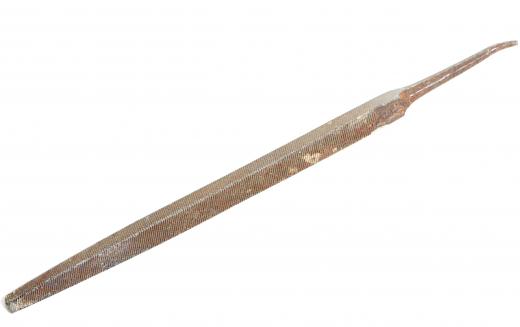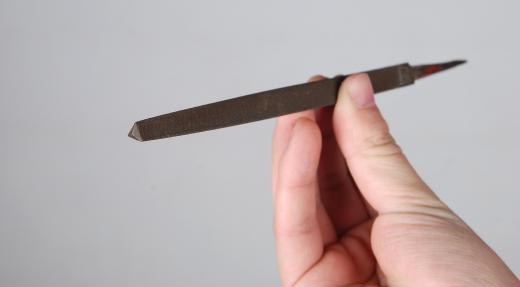A triangular file is a specialized tool for trimming and sharpening edges. Its unique, three-sided design makes it a great tool for sharpening hard-to-reach places such as saw teeth. With proper care and cleaning, this type of file will last for many years and consistently sharpen and smooth surfaces.
A triangular file looks much different than a traditional file. A traditional file is long and flat, with two rough sides, but the triangular file has three sides, each at a 60-degree angle. It also is known by the term "square file," even though it does not resemble that shape.

This type of file comes in a variety of lengths, usually ranging from 4 to 7 inches (101.6 to 177.8 mm), with its thickness increasing proportionally. Each file has a smooth end or wooden handle for users to grasp during use. Each of the three sides contains a series of grooves running in two diagonal patterns, creating a series of diamond shapes. These rough edges, when slid across an unfinished or dull surface, remove any excess material and smooth it.

The primary function of a triangular file is to work on angles, grooves and corners. Its unique shape makes its scope quite limited, and it is not recommended for jobs such as sharpening knives. One area in which these files exceed their flat-sided cousins is with saw blade sharpening. The tight notches between blade teeth make it impossible for a traditional file to get between the teeth and properly sharpen them.
Depending on the size of the saw, from tiny hacksaw teeth to large tree-cutting blades, a triangular file fits snugly between the teeth. Running the file between each individual tooth wears away the dullness and brings back a sharp point. This technique takes a generous amount of time but is the primary use of a triangular file.
This type of file's nontraditional uses and equally obscure shape make proper cleaning a necessity. It is advisable to rub chalk across each of the three sides to avoid clogging the grooves during use. If clogging occurs, a small wire brush is the best tool for dislodging any material within the grooves and still keeping those grooves tacky enough to function. No matter whether the job is sharpening a saw or some other specialized work, proper use and care of a triangular saw is essential.
